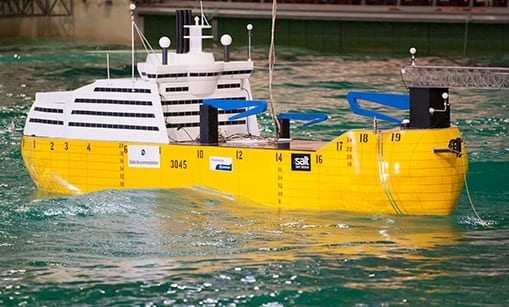
A decade of neglecting the National Institutes of Health budget has left a sector of science scrabbling to survive
I am a mass murderer of squid. I have cut off more Loligo pealei heads than you, and watched those heads writhe around in a bucket for a good three or four minutes post-decapitation—all in the name of federally funded science.
My squid-murdering days were back in the late 1990s, as a teenager in Woods Hole, Mass. I worked for a couple of summers at the Marine Biological Laboratory, an internationally renowned independent research institute famous for its basic science work; in particular on marine model animals like squid (which have a couple of easy-to-study giant nerve cells that I dissected out hundreds of times), lobsters, sharks and many others. In certain ways it represented a unique experience: The MBL is on a relatively short list of independent research institutions around the country that are discovery- and application-oriented counterparts to the university-based research enterprise.
And that laboratory is now the latest to feel a government-induced financial crunch that has made the MBL not so independent anymore. In June, the MBL voted to form an affiliation with the deep-pocketed University of Chicago; the MBL will remain a non-profit institution, but now has a stern “parent” paying out at least some of its allowance.
NIH funding going south
The MBL’s move and other independent institutes’ latest struggles can be accredited to a single acronym: NIH. After a massive decade-long expansion of funding for the National Institutes of Health (from $10 billion in 1993 to $28 billion in 2004), in the past nearly 10 years the budget for the country’s primary scientific funding arm stagnated and even declined some years (in 2013 the budget is $29.15 billion, down five percent from 2012, and well below the 2004 budget in today’s dollars). A science-unfriendly president (President George W. Bush) and Congress seemed unconcerned as the agency’s budget failed to keep up with inflation. Acceptance rates for grant applications have dropped precipitously as a result. More acutely, this year’s federal budget sequestration is cutting more than $1.5 billion and 700 research grants from NIH. At latest count, the acceptance rate for the standard grants known as R01s was14.9 percent, meaning more than 8 out of 10 applications go unfunded: there were more than 24,000 submitted in 2012.
“It’s going to slow down the pace of research,” says Larry Keinath, the current president of the Association of Independent Research Institutes and VP for finance and administration at the independent Wistar Institute in Philadelphia. AIRI represents the 80 or so independent research institutes around the country. “There are so many discoveries that we’re just on the verge of making…To pull back resources now is just a terrible time to be doing it.”
The Latest Bing News on:
Independent Research
- UNK students share their knowledge during annual Research Day celebrationon April 27, 2024 at 7:45 am
In its 26th year, Research Day is a campuswide celebration highlighting the creative and scholarly work produced by Lopers. Nearly 200 undergraduate and graduate students from a variety of academic ...
- How you can support HIV/AIDS research by 'Dining Out For Life'on April 25, 2024 at 8:32 am
Asheville restaurants are raising money for HIV prevention and care Thursday during the annual Dining Out For Life event, and you can help support the cause.
- HP's Next Gen Antivirus Given Perfect Score In Independent Teston April 25, 2024 at 8:11 am
Protection: Assessing the ability of the antivirus to safeguard against malware and various cyber threats. Performance: Measuring the speed and efficiency of the antivirus software across different ...
- Independent Bank (IBCP) Q1 Earnings and Revenues Top Estimateson April 25, 2024 at 6:15 am
Independent Bank (IBCP) came out with quarterly earnings of $0.76 per share, beating the Zacks Consensus Estimate of $0.65 per share. This compares to earnings of $0.61 per share a year ago. These ...
- Cost-of-living crisis still hitting students, research suggestson April 23, 2024 at 4:01 pm
The cost-of-living crisis is still affecting students as employers report a surge in graduates and apprentices quitting over dissatisfaction with pay, according to a new report. The Institute of ...
- IANS Research Receives Strategic Investment From the Apax Digital Funds to Accelerate Growth and Market Leadership in Information Securityon April 23, 2024 at 3:49 pm
IANS Research, the leading provider of independent research and advisory services for the information security industry, has announced a new strategic investment from the Apax Digital Fund II (the ...
- Independent Sector Releases New Value of Volunteer Time of $33.49 Per Houron April 23, 2024 at 12:00 pm
In addition to the national number, Independent Sector also provides the state-level value of volunteer time for all 50 states, the District of Columbia, and Puerto Rico. Values range from $15.82 per ...
- IANS Research picks up investment from Apax Digitalon April 23, 2024 at 10:34 am
As part of the transaction, Apax Digital's Marcelo Gigliani and Patrick Kane will join the IANS board of directors.
- LivePerson recognized by leading independent research firm as a Strong Performer in Conversation Automation Solutions for B2B reporton April 23, 2024 at 5:45 am
LivePerson (Nasdaq: LPSN), the enterprise leader in digital customer conversations, has been named a Strong Performer in "The Forrester Wave™: Conversation Automation Solutions For B2B, Q1 2024." ...
- Democracy Doesn’t Need Independent Candidates Like RFK Jr.on April 20, 2024 at 3:00 am
Candidates who represent no party or distinct point of view other than their own ambitions don’t make our system better. They’re often just spoilers.
The Latest Google Headlines on:
Independent Research
[google_news title=”” keyword=”Independent Research” num_posts=”10″ blurb_length=”0″ show_thumb=”left”]
The Latest Bing News on:
Fix the internet
- How to fix the ‘Not Registered on Network’ error on a Samsung Galaxy phoneon April 27, 2024 at 3:01 am
Have a Samsung phone? Seeing an annoying Not Registered on Network error and unsure what to do about it? Here's everything you need to know to fix it.
- The 43 Most Popular Amazon Items E! Readers Bought This Monthon April 27, 2024 at 3:00 am
A lot of us have experienced that one dead zone at home where the internet barely works and you just keep hitting refresh, waiting for a page to load until you just give up and head to another room.
- How to Fix the "No Internet Secured" Error on Windowson April 26, 2024 at 8:00 am
The message "No Internet, Secured" usually appears when your connection is weak. You can reboot your router to refresh your network, which might also improve its speed. Alternatively, you can also ...
- Federal subsidy connecting 367,000 Massachusetts households to internet is expiringon April 25, 2024 at 5:04 am
The federal program providing low-income households with $30 a month for internet access, is coming to an end. More than 50,000 households in Boston are currently enrolled in the program.
- How to Fix Search Results in the Windows 11 Start Menuon April 24, 2024 at 3:01 pm
Windows 11's start menu, by default, searches the internet and your computer at once. Here's how to keep things local.
- Algorithmic Curation Is Ruining The Internet. Here's How to Fix Thaton April 24, 2024 at 6:00 am
Machine learning researchers at Stanford have developed an innovative way to moderate online content—one that could potentially make the web less polarizing and divisive.
- Internet For Gaming: The Best NBN Plans To Help Fix Your Pingon April 23, 2024 at 9:57 pm
If your lagging is getting out of hand, you might be looking into finding the right internet for gaming. Here are our top tips and ISPs.
- Forward Thinking: Can feminism fix the internet?on April 23, 2024 at 5:37 pm
Dr Kerry McInerney is a research fellow at the Leverhulme Centre for the Future of Intelligence, University of Cambridge, and the AI Now Institute. This is the last of four programmes from the Oxford ...
- How to fix the VAN 84 error in VALORANTon April 23, 2024 at 4:10 pm
Disable IPv6: While less common, some users have reported success fixing the VAN 84 error by disabling IPv6. Close the Killer Prioritization Engine: This Intel-related background process was reported ...
- How Apple Could Help Small Businesses--and the Environment--by Making its Devices Easier to Repairon April 22, 2024 at 3:15 pm
Tech manufacturers are making it harder to fix devices. Here's how the right-to-repair movement hopes to make repairs more accessible.
The Latest Google Headlines on:
Fix the internet
[google_news title=”” keyword=”fix the internet” num_posts=”10″ blurb_length=”0″ show_thumb=”left”]









